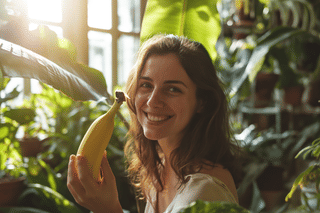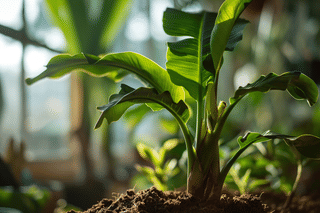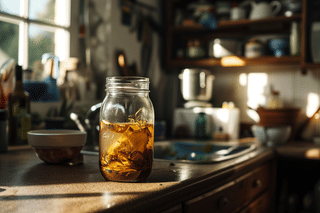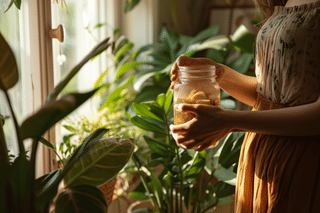How to use Banana Peels for Houseplants
Discover how to use banana peels for your houseplants with this easy-to-follow plant care guide. Learn how to fertilize and take care of your plants using this simple and effective method today!
Banana peels are much more than just waste. You can use them as an effective, natural fertilizer for your houseplants. The peels are filled with essential nutrients like potassium, phosphorus, and calcium. So banana peels can hugely improve the soil, making your plants healthier and stronger.
It's an amazing way to reduce your waste and help your plants at the same time. In this plant care guide, we'll look at the benefits of using banana peels for houseplants and how you can get started with them.
These are the topics we're going to look at:
Let's get started!
The benefits of using banana peels for houseplants
Before we dive into the specifics of how to use banana peels for your houseplants, let's explore the reasons why it's such a beneficial practice. Here are the main benefits of using banana peels for houseplants:
1. They're rich in nutrients
Did you know that banana peels can actually help your houseplants grow strong and healthy? These peels are packed with essential nutrients like potassium, phosphorus, calcium, and magnesium that plants need for their overall growth and health.
When you use banana peels on your houseplants, you're giving them a natural boost. The potassium and phosphorus in the peels support stronger stem and root growth, while also improving the plant's ability to absorb other nutrients.
2. They're a natural fertilizer
Banana peels make an excellent eco-friendly fertilizer that's gentle on your plants. They're packed with nutrients and help your plants grow more quickly without running the risk of getting rootburn from overfertilization.
But let me take one step back. Banana peels alone may not be a complete fertilizer solution. While they provide some nutrients, they might not decompose fast enough to give your plants what they need, exactly when they need it.
So if you do want to use banana peels to help feed your plant, you should use them as a supplement, not a replacement for a well-balanced fertilizer. Another thing to keep in mind is that different plants have different nutritional needs, so don't assume using banana peels will be a great fit for all plants.
3. They can prevent pests
Besides being a great eco-friendly way to help your plants thrive, banana peels also contain a compound called chitinase, which can help prevent pests around your houseplants. Chitinase is a natural defense mechanism in plants and fruits to protect themselves against several different insects.
This compound can also stimulate the growth of beneficial microbes in your soil, which protect the plant's roots against infections and help to keep your plant healthier.
The downsides of using banana peels for houseplants
Before you skip straight to the part where we learn how to use banana peels with our houseplants, let's look at a few things that you should know before you get started. Using banana peels for houseplants has a few downsides and challenges.
Unpleasant odor
Depending on the way you work with the banana peels, you could deal with an unpleasant odor. This happens when you let the banana peels decompose to let the nutrients release in the soil. For a greenhouse or outdoors this is usually no problem, but is not the nicest experience in your house.
If you want to use banana peels for houseplants, there are a few different ways to use banana peels that won't smell so bad.
Imbalanced nutrients
Banana peels are rich in potassium, but won't give your houseplants some of the other nutrients your plant needs to stay healthy. This is why you shouldn't replace your conventional fertilizers with banana peels, but use them as a supplement only.
Keep in mind that not all plants need the same levels of potassium to stay healthy, so if you add it to all plants, without doing a bit of research, you could be wasting your time feeding a plant that doesn't benefit from the potassium or even cause nutrient imbalances.
Further on in this guide, I'll share a few plants that could benefit from the increased levels of potassium.
Risk of pests
Banana peels help to repel certain pests, but if not done correctly, they could actually attract pests like fungus gnats to your plants. By following the steps in the next section, you can learn how to use the banana peels properly, so they don't attract pests.
How to use banana peels for plants
So you still want to use banana peels for your plants? Perfect! Let's look at a few different ways you can use the peels with your plants. Some of these are more useful for houseplants, while others are a good solution for plants you're going outdoors.
Homemade liquid fertilizer
Banana peels can be soaked in water for a few days to a few weeks to create a homemade liquid fertilizer. This "banana water" can then be used to water your plants, as you normally water them and this provides your plants with the nutrients the water has absorbed from the banana peels.
Creating homemade liquid fertilizer from banana peels can take a few days as you'll need to soak banana peels in water following a 1:4 (banana - water) ratio for about 1 - 2 days. This allows the nutrients from the banana peels to get absorbed into the water, creating a nutrient-rich liquid you can use to fertilize your plants.
Slow-release fertilizer
Banana peels can also be cut into small pieces and mixed directly into the soil. As they decompose, they release nutrients slowly, which can help to nourish your plants over time. Keep in mind, that this could start to smell, so perhaps it's best to only use this method for plants you can bring outdoors in the summer.
Compost
If you have a compost pile or bin, you can add your banana peels so they can contribute to creating rich, nutrient-dense compost that can be used to feed your houseplants. I've never personally used compost for my houseplants, so I can't go into more detail about this use of the banana peels unfortunately.
So these are 3 great uses for banana peels to help feed your plants. The first, the homemade liquid fertilizer, is the easiest and most convenient method to use for your indoor plants, so I'll use this method in the next section on how you can create this fertilizer.
How do you create a liquid plant fertilizer from banana peels?
The liquid plant fertilizer created from banana peels and water is the easiest and most convenient way to feed your indoor plants, so let's learn how we can create and apply this type of fertilizer.
Step 1: Collect banana peels
The first step in using banana peels for houseplants is to collect the banana peels. I recommend around 4 banana peels per 1 liter or 32oz mason jar, as this would get you a good concentration without making the mixture too strong. If you're not an avid banana eater, you can keep them in the freezer until you have enough to go to the next step.
Step 2: Add the banana peels to the jar
Once you've collected your banana peels, you can add 4 of them to a 1 liter (32oz) mason jar and add water until the jar is full. Then close the jar and let it sit for 1-2 days. This will let the water absorb the nutrients from the banana peels and the peels will start to decompose.
For the best result, you should cut up the banana peels into smaller pieces. This increases the surface area of the banana peel and helps it to release nutrients more quickly.
Step 3: Water your plants
After waiting for 1-2 days, the water in the mason jar and the banana peels should have turned brown. This means the water has absorbed the nutrients from the banana peels and is ready for you to use for watering your plants. After you've watered your plants, you'll want to discard the banana peels as they won't contain very many nutrients anymore.
Step 4: Repeat as needed
If you notice that your plant benefits from the banana water, you can repeat this process once per month to regularly give it a boost. Like normal fertilizer, don't do this during the fall and winter, as your plant will most likely be dormant. Your plant will benefit most from the banana water during the spring and summer when it's actively growing.
Which plants benefit the most from banana peel fertilizer?
It's important to keep in mind that not all houseplants will benefit the same way from banana peel fertilizer. Some plants really enjoy the potassium content in bananas, while others prefer a more balanced mix of nutrients. Now, let's look at a few different types of plants that could get a boost from the extra potassium in banana peels:
Flowering Plants
High potassium fertilizers can encourage blooming in plants like African violets, begonias, and orchids. So if you want to see more blossoms on your plants, try using banana peel fertilizer.
Fruiting Plants
Indoor fruit-bearing plants like tomatoes and strawberries can also benefit from high potassium levels, which can help to improve the quality of their fruit. Just make sure to use a balanced fertilizer alongside the banana peel fertilizer, as fruiting plants require more than just potassium.
Foliage Plants
While they might not need as much potassium as flowering or fruiting plants, foliage plants like pothos, philodendrons, and ferns can still benefit from a balanced fertilizer that includes potassium. This can help to keep their leaves healthy and strong.
Remember, the goal is to supplement your plant's diet with banana peels, not to replace a balanced fertilizer entirely. Also, note that over-fertilizing plants can lead to harmful nutrient imbalances. Always monitor your plants' response after each feeding to ensure they are benefitting from this homemade fertilizer.
Conclusion
To sum things up, using banana peels as a fertilizer for your houseplants can be a great idea. It's not only cost-effective and eco-friendly, but it also gives your plants a nice boost to thrive. With this guide, you've learned how to make your homemade fertilizer from banana peels, which plants benefit the most from it, and how to use it. Remember, the goal isn't to replace your regular fertilizer completely but to add this natural boost to it.
By using banana peels, you're becoming a more mindful and sustainable plant parent. Keep an eye on how your plants respond. If they like the banana peel fertilizer, then keep using it and enjoy watching your green friends flourish.
Thank you for reading this post! I hope it helps you to keep your plants healthy and beautiful! If you're looking for more guides on specific plants, you can always request a plant guide to get a guide for the plant you have trouble with.
Test your plant care knowledge
Quiz completed!
Want to learn more? Sign up for my newsletter to receive free tips in your inbox!
Sign up now!














